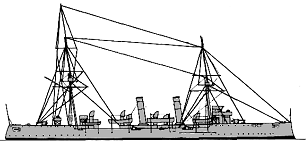
NAVYPEDIA
 Support the project with paypal
Support the project with paypal
Ships
| Name | No | Yard No | Builder | Laid down | Launched | Comp | Fate |
|---|---|---|---|---|---|---|---|
| Pioneer | Chatham DYd, UK | 16.12.1897 | 28.6.1899 | 11/1900 // 12.1912 | hulk 1924 | ||
| Psyche | Devonport DYd, UK | 11/1897 | 19.7.1898 | 1900 // 7.1915 | sold for BU 6.1922 |
Technical data
| Displacement normal, t | |
|---|---|
| Displacement full, t | 2135 - 2200 |
| Length, m | 91.4 pp 95.6 oa |
| Breadth, m | 11.1 |
| Draught, m | 4.88 |
| No of shafts | 2 |
| Machinery | 2 3-cyl. VTE, 16 Thornycroft boilers |
| Power, h. p. | 7000 |
| Max speed, kts | 20 |
| Fuel, t | coal 500 |
| Endurance, nm(kts) | 5500(10) |
| Armour, mm | steel; deck: 51 - 38, gun shields: 6, CT: 76 |
| Armament | 8 x 1 - 102/40 QF Mk I/III, 8 x 1 - 47/40 3pdr Hotchkiss Mk I, 3 х 1 - 7.7/94, 2 - 450 TT (beam, aw) |
| Complement | 224 |
Standard scale images

Pioneer 1912
Project history
The Pelorus class were very similar in appearance and general arrangement to the earlier Pearl class but were slightly smaller, with a lighter armament, and demonstrated a different approach to the problem of obtaining high speed. They had more powerful machinery that the the earlier class with a natural draught power of 5000ihp compared with 4000ihp, but forced draught power was restricted to a realistic 7000ihp which was 500ihp less than that in Pearl and her sisters. In order, therefore, to provide for the high designed speed of 20kts they were made longer and narrower than the Pearls, with a length to beam ratio of 8.2:1 compared with 6.5:1. The narrower beam also meant a reduction in the level of stability and although their lighter armament compensated for this to some extent, they proved to be poor sea boats, having a heavy roll and being very wet in heavy weather. Apart from the substitution of 102mm QFs for 120mm QFs, the gun armament was identical to that in the Pearl class and was disposed in the same manner. They were fitted with a variety of boilers to test the qualities of some of the many water tube types available. The results were varied and, while most of the class exceeded their designed power, making between 20 and 21kts on trial, they all suffered from a certain amount of boiler trouble and after a few years' service average maximum speeds were around 16-17kts. The least successful were Pomone and Pactolus, whose Blechynden boilers were so troublesome that the ships were removed from the effective list after only a few years' service.
Ship protection
Main deck has 38-32mm flat part and 51-44mm slopes. Thicker part was over machinery.
Modernizations
None.
Naval service
No significant events.
 HOME
HOME FIGHTING SHIPS OF THE WORLD
FIGHTING SHIPS OF THE WORLD AUSTRALIA
AUSTRALIA CRUISERS
CRUISERS PIONEER protected cruisers (1900/1912-1915)
PIONEER protected cruisers (1900/1912-1915)
